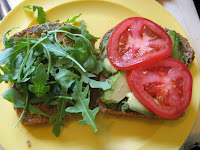
Even though I'm a dietitian, I don't believe in counting calories (or fat or carbs for that matter), in the strict sense, and I don't advise others to do it, even if they need to lose weight. The reason is because calorie counting is tedious at best, and, if you're susceptible to OCD or all-or-nothing thinking, the very act will drive you loony. Who wants to feel that way, when the GOAL is to feel great?
Nonetheless, the harsh reality is that calories do matter. Calories are merely the measure of energy in a food. So if a food contains 100 calories of energy, that 100 calories enters your body to do one of 2 things: 1) supply the energy your body needs to function (whether that be to think, walk, jump rope, produce a heartbeat, lift a dumbbell, or breathe), or, 2) become stored for later (fat). That's it, it's pretty simple. Where it gets complicated is asking questions about how many calories we need, which sources of calories (food) should we focus on and in what proportions, balancing calories with exercise, and so forth. Unfortunately we can get so caught up in the hype that we lose the big picture: Calories are a GOOD thing. They are our fuel for life. But when we overindulge in food, the excess energy gets converted into its ever-feared storage form: fat.
Last night my family went out to a local pub, as they offer face-painting and a kid-friendly atmosphere. I ordered an eggplant and red pepper panini (hold the fresh mozz cheese but please, yes, still DO charge for it), which, to my surprise and initial delight, came with a gigantic side of french fries: a rare treat. I tasted a fry and was immediately disappointed: they were tasteless. I had to add salt and ketchup to make them edible. After a few I stopped, realizing that the ketchup and salt were what I was enjoying, and why eat ketchup and salt plus a bland, deep-fried host-carrier? That's when I got the idea for this post: why even eat food that is loaded with calories but does nothing for our taste buds (and usually, nutrition)? If we're going to indulge in a rich food, shouldn't it be absolutely scrumptious?
I've come up with a top-ten list of calorie wasters: those foods that are high in calories but low in nutrients but don't taste delicious. In other words, "not worth it."
1.
French Fries. Unless the first bite makes you sigh with ecstasy, pass on the fries. You're eating mostly oil anyway. Want potatoes? Get one baked with the skin, or roasted with olive oil and rosemary. Yum.
2.
Store-bought national brand cookies. There was a time that I celebrated the fact that Oreos are vegan (they weren't always). And having one now and then is fine. But talk about a calorie waster -- Oreos are available EVERYWHERE, if I ever want one, so why splurge on something so everyday, so loaded with calories and fat, and completely devoid of anything health-supporting? Bake your own (at least you KNOW what's in them) and share with your neighbors. You'll feel better and save money and packaging. Plus you'll be very popular on your street.
3.
Bad chocolate. (Enough said.)
4.
Stale foods. Have you ever eaten those last few crackers, even though they've transformed into cardboard, because you didn't want to "waste" them? I have, and now I realize, they were wasted on ME -- better in the trash, and I should have grabbed a banana instead.
5.
"Buttered" popcorn. I know I said I'm not a numbers gal, but did you know that the glop you can add to movie popcorn (which is usually vegan, mind you, but possibly not suitable for human consumption) is primarily hydrogenated oil? According to an article from CSPI/Nutrition Action, a large popcorn has about 80 grams of fat (due to the oil it's POPPED in), and adding "butter" topping adds 50 more grams of fat? Do you really want 1170 calories from fat ALONE while you sit at the movies and barely taste what you're eating? I'm a fan of freshly popped movie popcorn, but I find if I share a no-"butter" small size with my movie partner, the indulge factor is just right, and I don't have to worry that I just clogged an artery.
6.
Sugary drinks. I once had a client who, after following my advice for weight loss, completely eliminated all calorie-containing beverages, and lost 55 pounds in 3 months. No other changes. 55 pounds. Mind you, he was drinking about three 2-liter bottles of Pepsi a day, which is unusual, but it demonstrates how quickly calories can add up and how they count just as much as calories in food. In fact, I would argue that the calories in drinks count MORE because the body does not have to work hard to digest it. If you have a sandwich, for example, you have to chew, digest, and assimilate all those nutrients, processes that require energy, so you're actually burning some calories just to process the sandwich. Sugary beverages, on the other hand, aren't much different than an introvenous feed of sugarwater. Go ahead and sip on sparkling organic grape juice now and then, but gulping down soda or juice on a regular basis is just a waste, pure and simple.
7.
Large portions. I've been guilty of this: I am out to dinner or eating at someone's home and I realize I am full, but I keep eating anyway because [insert excuse here]. People around me are eating, I don't want to insult the host, the food is really good, I don't want to waste food, I'm not paying attention to my satiety because I'm too busy socializing, etc. etc. etc. If you're full, stop. Food that goes into your body that it does not truly need is worse than trashing it: either way, the food has been made (thus waste is not really an issue at this point), and the only real difference between that food ending up in your stomach or the garbage is, it won't end up as body fat if its destiny is the trash. Feel guilty about wasting food? Ask for a doggie bag. Start composting. Best yet: take only a little food, and if you're still hungry, take seconds.
8.
Supersizing to "save." In this value-driven society, sellers tempt us to "maximize value" by spending just a little more to get a lot more of whatever it is you're buying. This is especially true for food. And who isn't tempted (for just one more dollar you can double your portion!)? But we must look at the "extra" we're getting and ask ourselves if we really need (or even want) extra. Extra food that our bodies don't need will, by design, end up as extra body fat. Remember, even if you pass up that great deal, you STILL end up with more money in your wallet at the end of the day. (On the other hand, I encourage this behavior at the grocery store for non-perishables: if you get a free can of beans if you buy 3, but you only need 2, by all means buy 3 and get the one free! You won't end up eating more; you'll just save some money.)
9.
Pre-sweetened stuff. From soy yogurt to breakfast cereal, it makes sense to buy the "plain" or "unsweetened" variety and doctor it up yourself. Maple & Brown Sugar instant oatmeal packets, for example, have 160 calories and 13 grams of sugar, while the plain has 100 calories and 0 grams of sugar per packet. You're better off eating the plain with a cup of chopped fresh apples and a dash of cinnamon for the same calories, plus a handful of nuts for smart calories and fat, and staying power so you're not famished by 10AM.
10.
Fancy coffee drinks. Consider this scenario: a week of Starbucks on your way to work, each time a grande (medium size).
Monday: Soy Caffe Mocha (250 cals)
Tuesday: Soy Cappuccino (110 cals)
Wednesday: Soy Gingersnap Latte (270 cals)
Thursday: Iced Soy Caramel Macchiato (220 cals)
Friday: Soy Hazelnut Hot Chocolate--Hey, it's Friday!... (510 cals--yup, that's sans whip).
Grand total: 1360 calories. Over a month's time, that's enough extra calories to make over a pound of body fat.
Need a morning buzz? Save about 1100 calories a week by choosing a Starbucks grande brewed coffee with a splash of vanilla soy milk. Better yet, save money and packaging and make it youself (a French press is great, or set up your machine the night before).
Deprivation stinks. That's not what this is about. It's about making minimal sacrifices and wise choices in order to maximize optimal health and longevity, while still leaving room for occasional indulgences. Isn't that ultimately what we all want?
(By the way: I only ate 1/2 my sandwich last night, so at lunch today I reheated it and added a spread of hummus--it was amazing. Hummus is a great mate for eggplant and peppers!)
 Tonight my Georgia (the state)-native mother-in-law helped me create a delicious vegan southern feast for dinner. Sorry we forgot to take pictures! I made this collage of the staples we used, which brought back memories for my MIL and got my preschooler excited about trying some new foods.
Tonight my Georgia (the state)-native mother-in-law helped me create a delicious vegan southern feast for dinner. Sorry we forgot to take pictures! I made this collage of the staples we used, which brought back memories for my MIL and got my preschooler excited about trying some new foods.
























